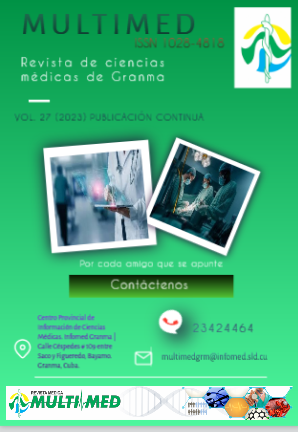Association of comorbidity and biomarkers with the risk of death by COVID-19 in critically ill patients
Keywords:
COVID-19, Prognostic factors, Comorbidity, Inflammatory reactants, Mortality.Abstract
Introduction: severe acute respiratory syndrome became a pandemic, and caused high morbidity and mortality worldwide, since there was no effective treatment or timely recognition of individuals with the worst prognosis.
Objective: to assess the ability to predict the risk of dying in patients with COVID-19, using a model based on prognostic factors.
Methodos: a cohort analytical study was carried out in patients with covid-19 treated in the services of the "COVID-19" hospital of the "Carlos Manuel de Céspedes" provincial general hospital of the Bayamo municipality, Granma province, since january 1, 2020 until december 31, 2022.
Results: the binary logistic regression model adjusted by the introduce method showed that the outstanding factors were, in order of importance, suffering from cancer (OR= 8.21; 95 % CI= 1.58-11.35; p= 0.023) followed by protein C reactive (OR= 7.91; 95 % CI= 4.46-9.87; p= 0.000) and arterial hypertension (OR= 7.15; 95 % CI= 4.41-11.42; p= 0.000). The Hosmer and Lemeshow test with a value of p= 0.582 with an indicator of good calibration of the model. The area under the ROC curve was 0.894 (confidence interval: 0.846-0.942; p=0.000), demonstrating the validity of the model.
Conclusions: the place of a history of cancer and high blood pressure as comorbidity related to the risk of dying from COVID-19is demonstrated, as well as inflammation reactants, where C-reactive protein, lactic dehydrogenase and erythrocyte sedimentation rate stand out. A model with adequate discriminative capacity is obtained.
Downloads
References
1. Zheng Z, Peng F, Xu B, Zhao J, Liu H, Peng J, et al. Risk factors of critical & mortal COVID-19 cases: A systematic literature review and meta-analysis. J Infect. 2020; 81(2): e16-25. DOI: 10.1016/j.jinf.2020.04.021.
2. Wynants L, van Calster B, Bonten M, Collins GS, Debray T, de Vos M, et al. Prediction models for diagnosis and prognosis of covid-19 infection: systematic review and critical appraisal. BMJ. 2020; 369: m1328. DOI: 10.1136/bmj.m1328.
3. Park SE. Epidemiology, virology, and clinical features of severe acute respiratory syndrome -coronavirus-2 (SARS-CoV-2; Coronavirus Disease-19). Clin Exp Pediatr. 2020; 63(4): 119-124. DOI: 10.3345/cep.2020.00493.
4. González-Tabares R, Acosta-González F, Oliva-Villa E, Rodríguez-Reyes S, Cabeza-Echevarría I. Predictores de mal pronóstico en pacientes con la COVID-19. Rev. cuba. med. mil ; 49(4): e918.
5. Luna-Bernal IJ, Justo-Enríquez LM. Factores de riesgo y pronósticos en pacientes atendidos por sospecha de Covid-19. Archivos en Medicina Familiar. 2021; 23(3): 127-35. DOI: https://doi.org/10.17843/rpmesp.2021.382.7158.
6. Yang X, Yu Y, Xu J, Shu H, Xia J, Liu H, et al. Clinical course and outcomes of critically ill patients with SARS-CoV-2 pneumonia in Wuhan, China: a single-centered, retrospective, observational study. Lancet Respir Med. 2020; 8(5): 475-81. DOI: 10.1016/S2213-2600(20)30079-5.
7. Águila-Gordo D, Martínez-Del Río J, Mazoteras-Muñoz V, Negreira-Caamaño M, Nieto-Sandoval Martín de la Sierra P, Piqueras-Flores J. Mortalidad y factores pronósticos asociados en pacientes ancianos y muy ancianos hospitalizados con infección respiratoria COVID-19. Rev Esp Geriatr Gerontol. 2021; 56(5): 259-67. DOI: https://doi.org/10.1016/j.regg.2020.09.006.
8. Mazumdar M, Glassman JR. Categorizing a prognostic variable: review of methods, code for easy implementation and applications to decision-making about cancer treatments. Stat Med. 2000; 19(1): 113-32.
9. Calvillo-Batllés P, Cerdá-Alberich L, Fonfría-Esparcia C, Carreres-Ortega A, Muñoz-Núñez CF, Trilles-Olaso, et al. Elaboración de modelos predictivos de la gravedad y la mortalidad en pacientes con COVID-19 que acuden al servicio de urgencias, incluida la radiografía torácica. Radiología. 2022; 64: 214-227. DOI: 10.1016/j.rx.2021.09.011.
10. Gupta A, Marzook H, Ahmad F. Comorbidities and clinical complications associated with SARS-CoV-2 infection: an overview. Clin Exp Med. 2023; 23(2): 313-31. DOI: https://doi.org/10.1007/s10238-022-00821-4.
11. Halvatsiotis P, Kotanidou A, Tzannis K, Jahaj E, Magira E, Theodorakopoulou M, et al. Demographic and clinical features of critically ill patients with COVID-19 in Greece: The burden of diabetes and obesity. Diabetes Res Clin Pract. 2020; 166: 108331. DOI: 0.1016/j.diabres.2020.108331.
12. Yang JK, Feng Y, Yuan MY, Yuan SY, Fu HJ, Wu BY, et al. Plasma glucose levels and diabetes are independent predictors for mortality and morbidity in patients with SARS. Diabet Med. 2006; 23(6): 623-8. DOI: 10.1111/j.1464-5491.2006.01861.x.
13. Tomidokoro D, Asai Y, Hayakawa K, Kutsuna S, Terada M, Sugiura W, et al. Comparison of the clinical characteristics and outcomes of Japanese patients with COVID-19 treated in primary, secondary, and tertiary care facilities. J Infect Chemother. 2023; 29(3): 302-8. DOI: 10.1016/j.jiac.2022.12.003.
14. Bertini CD, Khawaja F, Sheshadri A. Coronavirus Disease-2019 in the Immunocompromised Host. Clin Chest Med. 2023; 44(2): 395-406. DOI: 10.1016/j.ccm.2022.11.012.
15. Obregón-Santos Á, Adolfo-Prohias J, Pérez-Barreda A, Vila-García E. Insuficiencia cardíaca aguda en época de COVID-19. Revista Cubana de Cardiología y Cirugía Cardiovascular. [Internet]. 2020 [citado 16/05/2023]; 26(2): Disponible en: file:///C:/Users/Marlenis/Downloads/995-7141-1-PB.pdf
16. Salinas-Botrán A, Sanz-Cánovas J, Pérez-Somarriba J, Pérez-Belmonte LM, Cobos-Palacios L, Rubio-Rivas M, et al. Características clínicas y factores de riesgo de mortalidad al ingreso en pacientes con insuficiencia cardíaca hospitalizados por COVID-19 en España. Rev Clin Esp. 2022; 222(5): 255-65. DOI: 10.1016/j.rce.2021.06.004.
17. Hou W, Zhang W, Jin R, Liang L, Xu B, Hu Z. Risk factors for disease progression in hospitalized patients with COVID-19: a retrospective cohort study. Infect Dis (Lond). 2020; 52(7): 498-505. DOI: 10.1080/23744235.2020.1759817.
18. Yang Y, Xie J, Guo F, Longhini F, Gao Z, Huang Y, et al. Combination of C-reactive protein, procalcitonin and sepsis-related organ failure score for the diagnosis of sepsis in critical patients. Ann Intensive Care. 2016; 6(1): 51. DOI: 10.1186/s13613-016-0153-5.
19. Galicia GC, Santana Hernández GP, Vega Sánchez E. Asociación de ferritina con deterioro ventilatorio y mortalidad debido a COVID-19 en terapia intensiva. Med Crit. 2021; 35(3): 121-9. DOI: 10.35366/100000.
20. González Fajardo I, Linares Guerra EM, Díaz Padilla D, Godoy Lóriga LM, Amaury Núñez Betancourt. Cambios en variables hematológicas y velocidad de sedimentación globular de pacientes no críticos con la COVID-19. Rev Ciencias Médicas. 2020; 24(3): e4515.
21. Lapić I, Rogić D, Plebani M. Erythrocyte sedimentation rate is associated with severe coronavirus disease 2019 (COVID-19): a pooled analysis. Clin Chem Lab Med. 2020; 58(7): 1146-8.
22. Yan L, Zhang H, Goncalves J, Xiao Y, Wang M, Guo Y, et al. An interpretable mortality prediction model for COVID-19 patients. Nat Mach Intell. 2020; 2: 283-8. DOI: 10.1038/s42256-020-0180-7.
23. Pérez-Calatayud ÁA, Guillén-Vidaña A, Fraire-Félix IS, Anica-Malagón ED, Briones Garduño JC, Carrillo-Esper R. Actualidades en el control metabólico del paciente crítico: hiperglucemia, variabilidad de la glucosa, hipoglucemia e hipoglucemia relativa. Cirugía y Cirujanos. 2017; 85(1): 93–100. DOI: 10.1016/j.circir.2016.10.026.
24. Malha L, Mueller FB, Pecker MS, Mann SJ, August P, Feig PU. COVID-19 and the Renin-Angiotensin System. Kidney Int Rep. 2020; 5(5): 563-5. DOI: 10.1016/j.ekir.2020.03.024.
25. Khouchlaa A, Bouyahya A. COVID-19 nephropathy: probable mechanisms of kidney failure. J Nephropathol. 2020; 9(4): e35. DOI: 10.34172/jnp.20.35.
26. Carpio-Orantes LD, García-Méndez S, Hernández-Hernández SN. Neutrophil-to-lymphocyte ratio, platelet-to-lymphocyte ratio and systemic immune-inflammation index in patients with COVID-19-associated pneumonia. Gac Med Mex. 2020; 156(6): 527-531. DOI: 10.24875/GMM.M21000480.
Downloads
Published
How to Cite
Issue
Section
License
Avisos de derechos de autor propuestos por Creative Commons
1. Política propuesta para revistas que ofrecen acceso abierto
Aquellos autores/as que tengan publicaciones con esta revista, aceptan los términos siguientes:- Los autores/as conservarán sus derechos de autor y garantizarán a la revista el derecho de primera publicación de su obra, el cuál estará simultáneamente sujeto a la Licencia de reconocimiento de Creative Commons que permite a terceros compartir la obra siempre que se indique su autor y su primera publicación esta revista.
- Los autores/as podrán adoptar otros acuerdos de licencia no exclusiva de distribución de la versión de la obra publicada (p. ej.: depositarla en un archivo telemático institucional o publicarla en un volumen monográfico) siempre que se indique la publicación inicial en esta revista.
- Se permite y recomienda a los autores/as difundir su obra a través de Internet (p. ej.: en archivos telemáticos institucionales o en su página web) antes y durante el proceso de envío, lo cual puede producir intercambios interesantes y aumentar las citas de la obra publicada. (Véase El efecto del acceso abierto).







